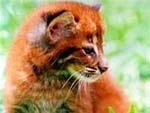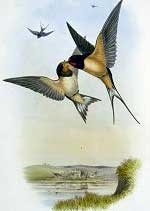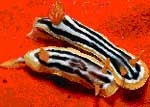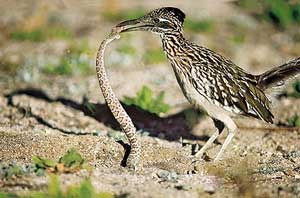 The bird known scientifically as Geococcyx californianus, commonly referred to as the Greater Roadrunner, is famous for its habit of crossing roads.
The bird known scientifically as Geococcyx californianus, commonly referred to as the Greater Roadrunner, is famous for its habit of crossing roads.
Although it is a bird, it has short wings which limit its flying ability; however, it runs incredibly fast, sometimes reaching speeds of over 24 km/h. Its long tail acts like a rudder, helping it change direction while running at high speeds. The Greater Roadrunner typically appears on roads, and when it senses danger, it will sprint away at astonishing speeds. They have a tendency to dash across roads frequented by vehicles. Despite their speed, they do not always make it to the other side—many have been flattened on highways by passing cars.
The Geococcyx californianus has a remarkable talent for catching and eating snakes, including highly venomous ones. For Native Americans, this bird symbolizes magic, strength, perseverance, and great bravery. It is also the state bird of New Mexico, USA. The Greater Roadrunner observes a snake from a close distance, waiting for the right moment to strike at the back of the snake’s jaw. Once it has secured its grip, it violently slams the snake against rocks or other hard surfaces to crush its bones. It then swallows the snake whole, though it usually does not ingest it all at once. It wanders around, dragging the snake in its mouth and swallowing it bit by bit while the snake’s body is gradually digested inside its stomach.
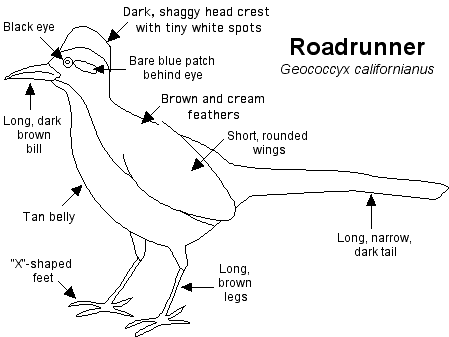
Anatomy of the Geococcyx californianus
In America, there are highly venomous rattlesnakes. The Geococcyx californianus knows how to subdue these dangerous snakes. It unexpectedly bites the tail of a coiled rattlesnake and whips the snake away as if it were cracking a whip, continuously smashing the snake’s head against the ground until it is dead.
The Greater Roadrunner can catch and eat snakes that are up to 0.6 meters long. Its diet consists of animals found on the ground, such as insects, lizards, snakes, scorpions, rodents, and small birds. They also eat fruits like prickly pear. Their diet is approximately 10% plant matter and 90% animal matter.
The body of the Geococcyx californianus is well adapted to desert life, feeding on moist animal-based food. The bird absorbs water from its feces before excreting it. Its nasal glands excrete excess salt, and the bird reduces its activity by 50% during the hottest parts of the day.
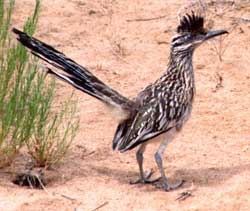 In the deserts of the Southwestern United States, it can be very hot during the day and quite cold at night. To maintain its body temperature at night, the Geococcyx californianus slows down its bodily functions, lowers its body temperature, and enters a state of torpor. However, by dawn, its body warms up quickly, and it resumes movement. This rapid warming is aided by a patch of black skin located between its wings, which helps it absorb heat from the weak rays of the morning sun. It fluffs up its feathers to expose the black skin and waits until its body reaches a normal temperature. Nevertheless, during winter, many birds still struggle against freezing temperatures.
In the deserts of the Southwestern United States, it can be very hot during the day and quite cold at night. To maintain its body temperature at night, the Geococcyx californianus slows down its bodily functions, lowers its body temperature, and enters a state of torpor. However, by dawn, its body warms up quickly, and it resumes movement. This rapid warming is aided by a patch of black skin located between its wings, which helps it absorb heat from the weak rays of the morning sun. It fluffs up its feathers to expose the black skin and waits until its body reaches a normal temperature. Nevertheless, during winter, many birds still struggle against freezing temperatures.
In addition to its preference for crossing roads and self-regulating its body temperature, the Geococcyx californianus exhibits interesting traits in its “social life.” They are monogamous and mate for life, residing in a specific area year-round. The male courts the female by presenting a “gift”, which may be an insect, a reptile, or something that looks appetizing. If the gift does not appeal to the female, she will leave immediately.
Both parents participate in nesting, creating nests in bushes that are shallow, tidy, and clean, made from twigs and lined with leaves and feathers. The nests are about 70 cm in diameter and are oval-shaped.
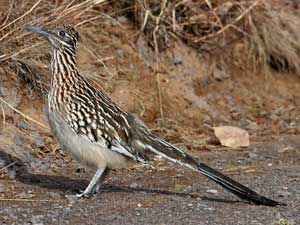 Each clutch consists of 2 to 8 eggs. The parents take turns incubating the eggs for 17 to 18 days. If food is scarce, the larger chicks will monopolize the food, leaving the smaller chicks to starve. Scientists are not sure exactly when the chicks learn to fly, but they can run and forage for food by the time they are 3 weeks old.
Each clutch consists of 2 to 8 eggs. The parents take turns incubating the eggs for 17 to 18 days. If food is scarce, the larger chicks will monopolize the food, leaving the smaller chicks to starve. Scientists are not sure exactly when the chicks learn to fly, but they can run and forage for food by the time they are 3 weeks old.
The Geococcyx californianus has a slender body, strong legs, and a long tail. Two toes point forward, while two others point backward. A feathered crest on its head raises and lowers whenever the bird feels curious or surprised.
During courtship, they produce cooing sounds similar to doves. While nesting, the female emits melancholic calls. They can create clattering sounds by striking their upper and lower mandibles together—one of the most unique abilities in the avian world.
This road-crossing bird is widely distributed across the western parts of North America, thriving in open, dry areas with sparse dry brush. On average, these birds measure about 60 cm in length, stand approximately 30 cm tall, and have a lifespan of around 7 to 8 years.








































